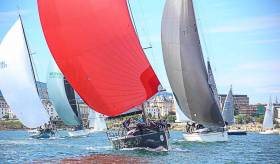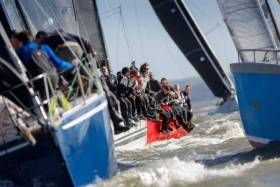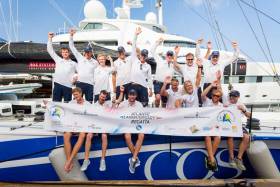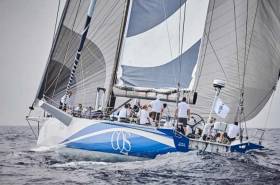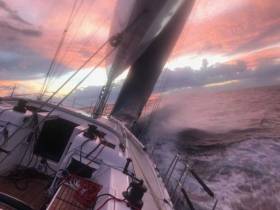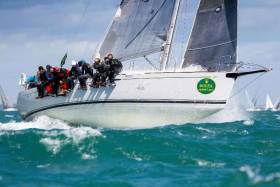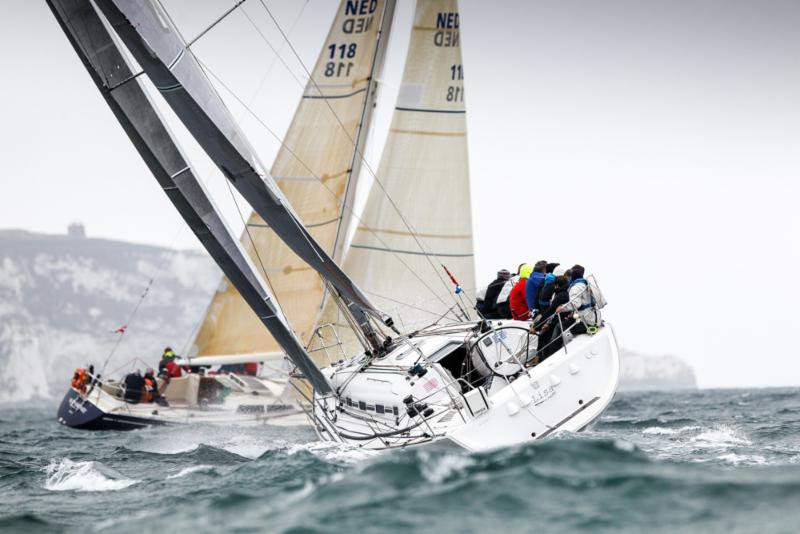Displaying items by tag: RORC
RORC Says IRC Certificates Show Positive Start for 2018: Irish Take Up 'Same as Last Year'
The International Rating Certificate (IRC) has made a flying start to 2018 with increased numbers of rating applications in the first month of the year and nearly 1000 certificates issued in January. RORC says 'This is very positive for IRC as certificates are not automatically renewed. Owners must apply for a new certificate through their local IRC Rule Authority and advise any changes to the boat’s configuration before the certificate is issued by the RORC Rating Office or UNCL Centre de Calcul, joint owners and administrators of IRC'.
In Ireland, Irish Sailing says they have have had 50 IRC revalidation applications plus four trial cert applications so far this season. According to Chief Executive Harry Hermon, this is trending 'exactly the same as last year'.
2017 saw total Irish certs of 419 (includes all applications – revalidation, new, trial, amendment etc) so the view is that this will be the same in 2018, with a 'possible small increase'.
March/April/May/June are the peak months for IRC applications in Ireland.
Changes to the IRC rating calculations are implemented every January to cater for technical innovations in yacht design, a practice implemented by the IRC Technical Committee to foster close racing and protect the main fleet while remaining progressive.
Over the last 12 months the Technical Committee has been studying the effects of foils and how they are rated. Boats such as Infiniti 46 Maverick using the Dynamic Stability System will see a change in her rating from which she will benefit for the upcoming RORC Caribbean 600. Other developments for Spinlock IRC 2018 include changes to the calculations affecting: the rating of spinnaker area, sports boats, and boats that set headsails from bowsprits and do not carry spinnakers.
The ‘dayboat’ classification has also been removed from the Rule, leaving assessment of boats’ Offshore Special Regulations compliance to event organisers.
Irish Sailors Join Class Acts for the Caribbean Classic
With just over a month before the start of the 10th edition of the RORC Caribbean 600, over 60 yachts have officially entered the Caribbean classic. Superyachts, maxis, multihulls and a vast array of racing and cruising yachts will be taking on the beautiful, yet challenging race around 11 Caribbean islands.
Perhaps as many as 20 Irish sailors are taking part in all, and the preliminary list shows that Adrian Lee’s Cookson 50 Lee Overlay Partners (Royal St George YC), winner of the first RORC Caribbean 600 in 2009, is back in the hunt and up against such other noted Cookson 50s as American Ron O’Hanley’s Privateer, runner-up in the Rolex Fastnet Race 2017.
Ian Moore of Carrickfergus, overall winning navigator of Hap Fauth’s Maxi 72 Bella Mente in last year’s Caribbean 600, is going again, but aboard a boat of a different vintage. Just this morning in New York, he signed up to pilot the Elliott 52 Outsider, a 1997 New Zealand design though built in 2006 and still a very competitive proposition generally - particularly so with Moore calling the shots.
Conor Fogerty’s Sunfast 36000 Bam! (Howth YC, class winner in 2016) is very much in the hunt, his crew including Mini-Transat veteran Tom Dolan. Irish-French interest is further maintained with popular Round Ireland contender Eric de Turckheim of La Rochelle with his new 54ft Teasing Machine, overall winner of the recent east-west RORC Transatlantic Race.
In IRC Two, last year's winner and sixth overall, El Ocaso is looking for a charter and is one of three J/122s entered this year, alongside Pamala Baldwin's Antiguan Liquid and Bernard McGranaghan's French Noisy Oyster.
"It's exciting, exhilarating, exhausting and filled with the spirit of adventure. We are brave-hearts with a mission - to dig deep and give it our best. We learn to expect the unexpected. We bond and make lifelong friends and cherish priceless memories," says Pamala Baldwin, owner of J/122 Liquid.
Two Antiguan yachts scored memorable victories in 2017, Bernie Evan-Wong's RP37 Taz was the winner of IRC One and Jonty and Vicki Layfield's Swan 48 Sleeper X was the winner of IRC Three.
Sleeper X will be one of the oldest yachts competing and is a true classic, but there is more than meets the eye to the 1973 Olin Stephens design. Under her former name Jacobite, she won three back-to-back Swan European titles and was class winner at the Swan Worlds:
"We have had a number of Swans, but this one is special," commented Jonty Layfield. "Despite her age Sleeper is in really good condition and we love to cruise as well as race. Winning class last year was fantastic and we would love to repeat that. We were also ninth overall and it would be amazing if any of the smaller yachts could break into the top five this year. The core Sleeper crew has been racing together for over 20 years and we also have talented young Antiguan sailors on board, which is a great mix and it is really rewarding to help young talent develop."
Two all-women teams will be competing in the 10th edition of the RORC Caribbean 600. Miramar Sailing's Grand Soleil 46.3 Phoenix, skippered by Pippa Turton will have a crew of nine, and Girls for Sail's Beneteau First 40.7 Hot Stuff, skippered by Sophie O'Neill returns having finished last year's race during the prize giving after over five days at sea.
"We pushed really hard to make it in time for the party and it was one of the best evenings. I love racing with the RORC because they really put on well managed and enjoyable racing," commented O'Neill. "I was delighted to hear that there will be another all-female team in this year's race. I am sure we will want to meet up beforehand to get to know each other and share a few drinks afterwards, but during the race, it will be very competitive."
The 2018 RORC Caribbean 600 starts from Antigua on Monday 19th February.
Link to current entry list here
Entry Opens for IRC European Championship & Commodores' Cup + all RORC races on 8th January 2018
At midday on Monday 8th January 2018 entry will open for all Royal Ocean Racing Club (RORC) races, including the Season's Points Championship comprised of 14 races, as well as the highlight of the UK Solent season - the IRC Europeans and Commodores' Cup.
Competitors entering the IRC Europeans (8-16th June) are invited to form a team of three boats with members of their own yacht club or with boats from their region. Alternatively, contact the RORC Race Team who will provide a list of boats entered, but not yet part of a team.
The biggest contest in the 2018 RORC programme is the Sevenstar Round Britain and Ireland Race on Sunday 12th August. At 1,805 nautical miles, it is three times longer than a Fastnet Race and attracts experienced offshore sailors looking for a serious challenge. Starting and finishing in Cowes, it is on a four-year cycle due to the toughness of the race. Circumnavigating all the islands of the UK, including the most northerly point Muckle Flugga, it negotiates headlands with tidal challenges all around the UK and faces the notorious British weather.
The Royal Ocean Racing Club's UK domestic season fires up with the Easter Challenge (30th March to 1st April) and offers crews the chance to work on pre-season training and fine-tuning. With the relaxation of RRS41, the highlight of the event is the availability of a selection of experienced coaches on the water to assist with getting back up to speed.
French Teasing Machine is Overall Winner of 2017 RORC Transatlantic Race
Eric de Turckheim's French Nivelt-Muratet 54 Teasing Machine is the overall winner of the 2017 RORC Transatlantic Race. Whilst many of the record 23–yacht fleet are still racing, none of them can better Teasing Machine's corrected time under IRC. Teasing Machine is the smallest yacht to win the RORC Transatlantic Trophy which has been previously won by yachts in the Maxi Class.
"To win the RORC Transatlantic Race is just fantastic," commented Eric de Turckheim. "It is not just a personal achievement to win my first ever transatlantic race because it has been such a massive team effort. Teasing Machine was only taking part in its second offshore race and to build a team to that performance level within four months has required a huge commitment from everyone, but especially Laurent Pages."
Teasing Machine tactician Laurent Pagès and Navigator Jean-Luc Nélias form a formidable partnership. The Frenchman took the same roles for skipper Franck Cammas, winning the 2011-12 Volvo Ocean Race, and Nélias won this year's Transat Jacques Vabre on Sodebo Ultim with Thomas Colville, smashing the race record.
"There were three main stories to this book," explained Laurent Pagès. "The start of the course put us in the wind shadow of the Canary Islands which was very difficult, but we had a very good first 24 hours. It was very important to be as early as possible to the ridge of high pressure because the door would close at some stage, and we did a very good job crossing the area of light winds. After that we knew we would have to go south eventually and we tried to remain in the pressure. Teasing Machine is a powerful boat that likes to stay in the wind. It has been a privilege to discuss the strategy of the race with Jean-Luc Nélias. It is another great victory and I hope there will be many more."
RORC Chief Executive Eddie Warden Owen was very pleased with the result and the race: "It has been no easy task for the Teasing Machine team to win this race and they have been pushed hard by a number of very competitive boats. Eric and his team showed their determination and expertise, setting a strong pace from day one and never letting up. This race marks the start of the 2018 RORC Season's Points Championship and Teasing Machine has set the standard required for the rest of the fleet who have their eyes on this prestigious prize."
Kenefick & Espey Take Transatlantic Line Honours on CQS
Ludde Ingvall's Australian Maxi CQS finished the 2017 RORC Transatlantic Race on Wednesday 6th December taking Monohull Line Honours in an elapsed time of 11 days 00 hrs 03 mins 08 secs. CQS committed to a southerly route for the 3,000 nautical mile race and despite sustaining sail damage in a vicious 40 knot squall, the canting keel 98ft Maxi led from start to finish. Ingvall is no stranger to taking line honours in prestigious offshore races, twice taking the honour in both the Rolex Fastnet Race and the Rolex Sydney Hobart Yacht Race. This was Ludde Ingvall's 16th transatlantic.
Once dockside at Camper & Nicholsons Port Louis Marina, Ingvall was full of enthusiasm for the RORC Transatlantic Race and his team:
"We have had a fantastic trip, even though the slow start meant we didn't have a fast race, but I love it. It is great to be back in the Atlantic and especially nice to be first. Much more fun than being last! We have a young crew on board and it is especially rewarding to give them this chance and 'pass it on'. Sailing is an amazing sport, but big boat opportunities for young sailors are few and they did really well. Just think, we have eight nationalities on one boat and everybody was focused on the same finish line. We worked as a team, looked after each other and it was tough at times."
After the Australian Maxi had safely moored at the impressive Superyacht Dock, CQS received a warm welcome from RORC Race Officer Steve Cole and Glynn Thomas, General Manager at Camper & Nicholsons Port Louis Marina. Patricia Maher, Chief Executive Officer at Grenada Tourism Authority presented Ludde Ingvall and his team with a basket of Grenadian produce.
CQS has now set the bar for the best corrected time under IRC for the RORC Transatlantic Race Trophy. The defending champion, Marten 72 Aragon, skippered by Jochen Bovenkamp and Canadian Southern Wind 96 Sorceress, skippered by Daniel Stump are likely to be the next yachts to finish. The Maxis have close company from two high-performance offshore racing yachts, Tilmar Hansen's German Elliott 52 Outsider and the provisional overall leader, Eric de Turckheim's French Nivelt-Muratet 54 Teasing Machine. All four yachts are expected to finish the 2017 RORC Transatlantic Race on Friday 8th December.
Atlantic Knockdown for Kenefick & Espey on Ingvall's CQS
Irish sailors David Kenefick and James Espey on board Ludde Ingvall's CQS suffered a setback in the RORC Transatlantic Race; the westbound leg of the Atlantic Anniversary Regatta. "We got caught in a bad squall of probably 40 knots which resulted in a number of issues," Ingvall reported from on board on day 10 of the race. "There has been damage to sails and onboard electronic systems, but we are still progressing towards the finish."
Kenneth Thelen, co-skipper for Australian Maxi CQS confirmed that all of the crew of the 96ft canting keel Maxi were safe and well. Describing the damage he said: "Part of our electronics failed making it hard to sail in the dark. We blew our biggest spinnaker, but it is repairable. As we went into a gybe, the engine stalled and we lay flat on our side for a while which resulted in a diesel spill inside the boat, so the smell is terrible in the heat! We broke the top three battens in the mainsail, but we are still sailing towards the finish at reasonable speed, in pouring rain. We will assess the situation at first light."
At 1100 UTC on December 4th, the race tracker showed that CQS had slowed down to barely a few knots of boat speed to effect repairs. "We are back on track," continued Ingvall. We lost about six hours while sailing slowly and then stopped to repair probably at 90-95%, but we are now doing 14-15 knots average with G1 and a full main."
At the time of the incident CQS was more than 400 nautical miles ahead of Jochen Bovenkamp's Dutch Marten 72 Aragon and Southernwind 96 Sorceress, skippered by Daniel Stump. CQS are fighting all the way to hold onto their grip on the IMA Transatlantic Race Trophy.
Eric de Turckheim's French Nivelt-Muratet 54 Teasing Machine leads overall after IRC time correction and the majority of the record fleet are reaching at double-digit boat speed towards the finish at Camper & Nicholsons Port Louis Marina, Grenada.
Australian Maxi CQS – with David Kenefick & James Espey Onboard – Chooses Southerly Transatlantic Route
As dawn broke on the third day of the RORC Transatlantic Race, the northerly route across the Atlantic looks to be the favourite for many of the 23 teams taking part in the race. Jens Kellinghusen's German Ker 56 Varuna leads the charge towards the low pressure system which has attracted the fleet to this route. The low has moved further north east than predicted allowing the fleet to take a more direct heading across the Atlantic. To the south, the convergence zone, acting as a barrier to the tradewinds, is the focus of attention for Ludde Ingvall's Australian Maxi CQS – with Royal Cork's David Kenefick and Royal Ulster's James Espey onboard – which has chosen the southerly route.
After beating into big seas for most of the second day, CQS tacked south at around midnight last night. To reach the tradewinds, CQS need to cross a convergence zone, an area of scarce wind approximately 100 miles across. The Australian Maxi has pointed their bow towards the coast of Senegal, West Africa and will be hoping to have picked the narrowest gap. By sharp contrast, Roman Guerra's Volvo 70 Monster Project is 370 nautical miles (682 km) north of CQS, blasting along on a tight reach into the low pressure system and experiencing close to gale force conditions.
Varuna has been the fastest yacht in the fleet, racing close to 300 miles in the last 24 hours, and of the yachts north of the rhumb line, Varuna is closest to the finish. Amongst the Maxi Yachts, Canadian Southern Wind 96 Sorceress, skippered by Daniel Stump has passed Jochen Bovenkamp's Marten 72 Aragon and pulled out a six mile lead. However, Eric de Turckheim's French Nivelt -Muratet 54 Teasing Machine continues to impress, as does Bo Teichmann & Thomas Jungblut's German Elliott 52 Outsider. The two smaller yachts have covered a similar distance as the two Maxis in the last 24 hours.
In the Class40s, Mathias Mueller von Blumencron's Red has covered 200 miles in the last 24 hours, to pull out a 30 mile lead on Berthold and Tobias Brinkmann's MarieJo. Gerald Bibot's Belgian 42ft Catamaran Zed 6 is north of the Class40s and is now clear of the wind shadow of the Canary Islands.
In IRC Zero, two young German teams are locked in a close battle. JV52 Haspa Hamburg, skippered by 21 year-old Max Gaertner, and JV53 Bank Von Bremen skippered, by Alexander Beilken. In IRC One, Bjoerne Woge's Andrews 56 Broader View Hamburg has raced 176 miles in the last 24 hours, more than any other team in the class.
Friedrich Boehnert's Xp-50 Lunatix, and Chris Stanmore-Major's Whitbread 60 Challenger have for now chosen to race the rhumb line towards Camper & Nicholsons Port Louis Marina in Grenada. Arno Boehnert aboard Lunatix is already looking forward to the spice of Grenada.
"It's all good on board Lunatix, but we are bashing upwind at the moment," reported Arno Boehnert in a race blog. "Tonight we are eating our delicious freeze-dried food with hot sauce, which you never want to forget when you are racing the Atlantic! Rounding the (Canary) Islands we had a pretty tough day with everything from light winds to strong gusts, so we really needed to stay focused. Earlier we had a great battle with Broader View Hamburg, but now no other boats are in sight. We are on our own."
Tracker here
Ocean Yacht Racing Goes Mainstream. Is Irish Sailing Ready? And Willing?
With three major yet very different marathon sailing events crossing the Atlantic this month, it’s clear that the once decidedly quirky and often eccentric devotees of offshore and ocean racing are becoming mainstream. This is further reinforced by the confirmation – which has been flagged for a long time now – that World Sailing and the Olympics organisation will be evaluating an experimental two-handed and possibly gender-mixed offshore contest in parallel with the sailing events at the Tokyo 2020 Olympiad. W M Nixon wonders if long-serving offshore racing enthusiasts will really be a hundred per cent in support of these developments.
In sailing as in politics, ultimately everything is local. We’d always been interested in the Mini-Transat, but never more than the time when Enda O’Coineen did it rather longer ago than he cares to remember. And when the second stage of this year’s race got going from Las Palmas to Martinique on November 1st, the hearts of the Irish sailing community were with our folk hero Tom Dolan, the farmboy from Meath who has shown he can cut it with the best of them in this uniquely demanding branch of the ocean game.
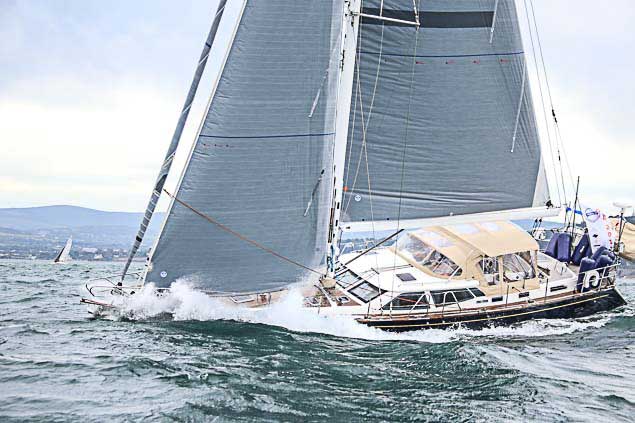 Never mind the weather, the tent is up and setting a treat…..Unlike the Mini-Transat boats which crossed the Atantic two weeks in advance of them, the crew of former Round Ireland winner Eamon Crosbie’s Discovery 55 Pamela will be enjoying considerable comfort during the ARC 2018. Photo David O’Brien/Afloat.ie
Never mind the weather, the tent is up and setting a treat…..Unlike the Mini-Transat boats which crossed the Atantic two weeks in advance of them, the crew of former Round Ireland winner Eamon Crosbie’s Discovery 55 Pamela will be enjoying considerable comfort during the ARC 2018. Photo David O’Brien/Afloat.ie
Then when the huge ARC 2017 got its incredibly varied fleet lumbering away last weekend, again from Gran Canaria, this time towards St Lucia, we tried to take an overview of the fleet, but inevitably became focused on Eamon Crosbie’s Discovery 55 Pamela from Dun Laoghaire with a merry crew on board. We’ve been observing that, like the rest of the fleet, she has found anything but regular northeast tradewinds out in the Atlantic, but she’s getting there nevertheless – race tracker here
This weekend, there’s some quite heavy metal – some of it distinctly luxurious in tone – getting started in the RORC’s Transatlantic Race from Lanzarote, with the finish in Grenada. The fleet of 23 make up in quality what it lacks in quantity, for though the smallest boat is the JPK 10.10 Jangada, the largest is Daniel Stump’s Southernwind 96 Sorceress, while the longest is Ludde Ingvall’s uber-skinny 98ft Maxi CQS from Australia.
It’s aboard this extraordinary yoke that Ireland’s Sailor of the Year 2013 David Kenefick, now 26, is sailing as skipper. In an acknowledgement to the sheer power and reach of the French sailing scene, the young Cork sailor had been declared “Rookie of the Year” in the Figaro Solo circuit in 2013, and to the surprise of some of the more traditionally-minded adjudicators, this was seen by the sailing public as more important than some major achievements within Ireland, so four years ago Kenefick became their Number 1.
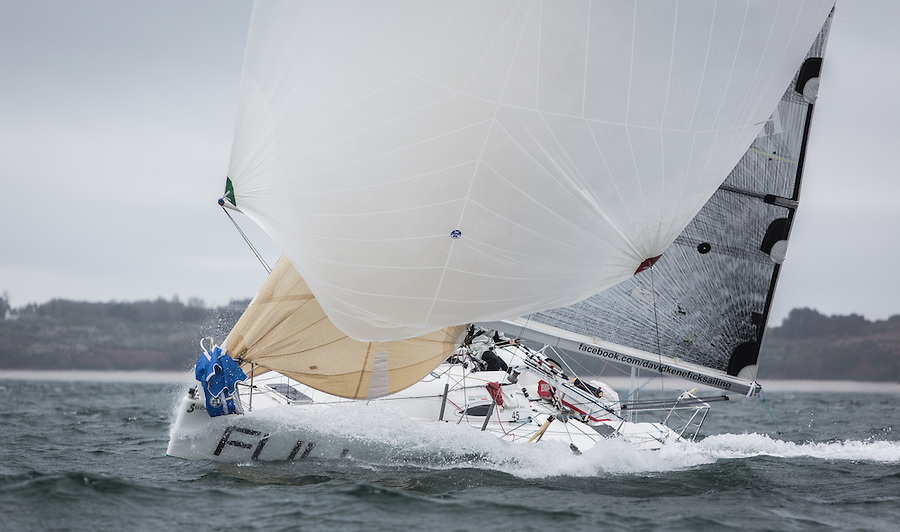 Somewhere in there on his Figaro Solo is David Kenefick, Ireland’s “Sailor of the year” 2013. Photo: Brian Carlin
Somewhere in there on his Figaro Solo is David Kenefick, Ireland’s “Sailor of the year” 2013. Photo: Brian Carlin
"Ludde is a legend and it is a great privilege to sail with him as skipper of CQS,” commented Kenefick. We have a young and multinational crew and we cannot wait to take on the challenge. CQS is a fantastic race boat and I am sure we are all going to learn so much after 3,000 miles.”
“In my early days I had the pleasure of racing with Harold Cudmore and we are still great friends,” said Ludde Ingvall. “I remember meeting with Harold and asking him what drives us on, now that we have been racing so many years. He replied we must 'pass it on' and that is what we are doing for young sailors that show great ability and the attitude to succeed.”
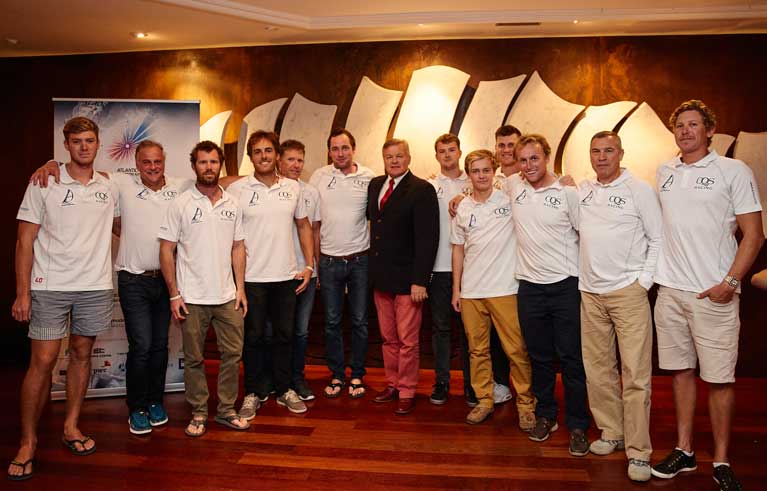 CQS crew – 26 year old Dave Kenefick pictured (centre) with Ludde Ingvall at tne gala dinner and his Australian 98ft Maxi CQS in the RORC Transatlantic Race starting from Lanzarote. Also pictured (fourth from left) is Royal Ulster Olympian James Espey
CQS crew – 26 year old Dave Kenefick pictured (centre) with Ludde Ingvall at tne gala dinner and his Australian 98ft Maxi CQS in the RORC Transatlantic Race starting from Lanzarote. Also pictured (fourth from left) is Royal Ulster Olympian James Espey
It will be intriguing to learn from one of our own just what it’s like to sail on something like CQS, which you can see as either counter-intuitive, or else so very intuitive that she has come out the other side. And with Kenefick on board, we will be keeping a special eye on her showing as the longest boat.
In between CQS and the “little” Jangada, there’s an eclectic selection including that old war horse, the Volvo 70 Monster Project (Roman Guerra). But generally they’re top end boats of comfortable size while being competitive at the same time. And with a considerable emphasis on European entries (there are boats from nine countries), they’re living proof that the story of the Eurozone’s economic recovery is true, and it’s out there and floating on the Atlantic.
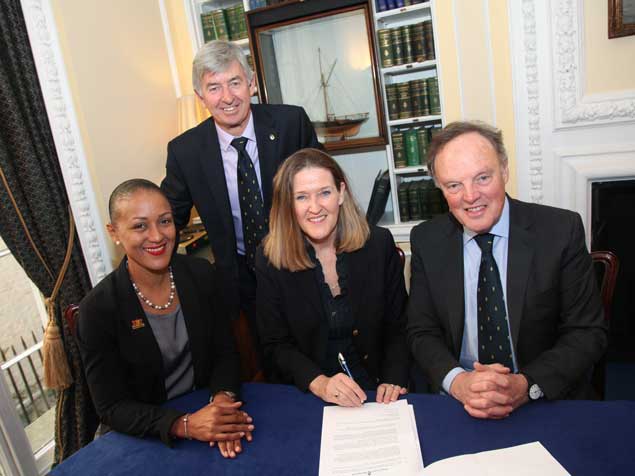 At the signing of the agreement to stage the RORC Transatlantic race from Lanzarote to Grenada are (left to right) Francine Stewart (Marketing Manager, Grenada Tourism Authority), Eddie Warden-Owen (CEO, RORC), Patricia Maher (Grenada Tourism Authority) and Michael Boyd (Commodore, RORC)
At the signing of the agreement to stage the RORC Transatlantic race from Lanzarote to Grenada are (left to right) Francine Stewart (Marketing Manager, Grenada Tourism Authority), Eddie Warden-Owen (CEO, RORC), Patricia Maher (Grenada Tourism Authority) and Michael Boyd (Commodore, RORC)
Typical of this is hyper-keen French owner-skipper Eric de Turkheim from La Rochelle, who we also feel is one of us, for if it hadn’t been for Rambler 88’s almost freakish performance in last year’s Volvo Round Ireland Race, his unusual-looking but effective Teasing Machine II would have been the overall winner.
Since then he has come up with the new 54ft Teasing Machine III, and though she wasn’t ready in time for the Fastnet Race in August, she made an impressive debut in the Middle Sea Race in late October, and would have been second overall if another of those pesky JPK 10.80s, this time the Russian-owned Bogatyr, hadn’t come out of the woodwork at the end, and snatched the win by six minutes, while Teasing Machine II was relegated to a close third overall.
So between CQS and Teasing Machine, we have favourites to follow. And although the RORC fleet start all of a week after the ARC, the winds along the sunshine route to the Caribbean are in such a wayward mood that it’s going to be fascinating comparing the relative performance of the two groups.
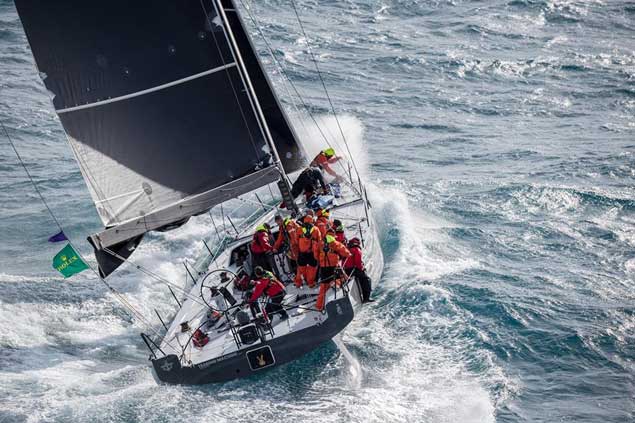 The new 54ft Teasing Machine II on her way to third overall in her first major event, the Rolex Middle Sea Race 2017. Photo Rolex
The new 54ft Teasing Machine II on her way to third overall in her first major event, the Rolex Middle Sea Race 2017. Photo Rolex
But what on earth, you might well wonder, is all this recitation of Atlantic voyagers and racers to do with giving only two instead of three cheers for the prospect of World Sailing shoe-horning offshore racing into the Olympics?
It’s simple. Offshore racing and its many organisations and events are so varied that trying to channel them into the narrow perspective of the Olympics, with its over-long four year cycle, is going to result in a very artificial construct. And the idea of having a man-and-woman crew of two who are declared to be the World Champions and Olympic Gold Medallists is so remote from the delicious, invigorating and multi-interest variety of the current offshore and ocean scene that we could be talking about two different planets.
For sure, it’s a notion which will appeal to newspaper headline writers. In the real red-top trade, sailing only makes sense when it’s in the Olympics or somebody is drowned. Beyond that, it’s simply too complex, varied and – let’s face it – self-absorbed, to promote itself as some sort of arena sport.
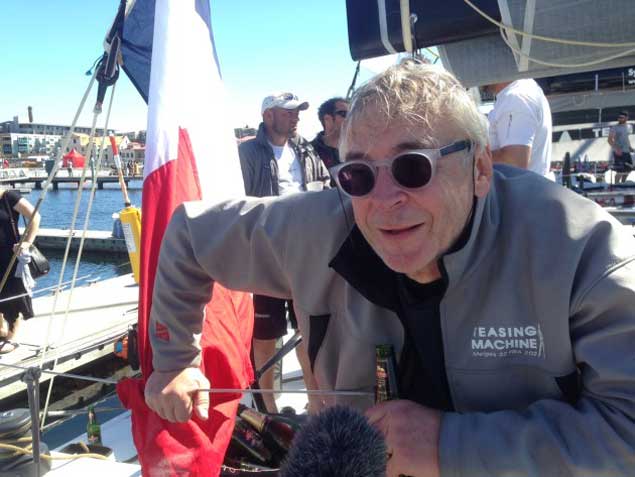 Eric de Turkheim, popular owner of Teasing Machine III, in Sydney preparing to race Teasing Machine II with success in the Sydney-Hobart Race
Eric de Turkheim, popular owner of Teasing Machine III, in Sydney preparing to race Teasing Machine II with success in the Sydney-Hobart Race
It was quite some time ago when two top honchos in American sailing announced that they were determined to reduce the number of world titles recognized by the then International Yacht Racing Union, which went on to become ISAF, and is now World Sailing. Back in the day, these guys reckoned that the 143 different IYRU-recognised classes with International status being each entitled to their own World Championship was a nonsense, and numbers should be reduced.
You can see why they thought so. One hundred and forty three sailing world champions might seem a bit over the top. But the idea went down like a lead balloon. People cherish their own classes, they cherish their own world titles, and they cherish their own local setup. And though they take a polite interest in World Sailing’s new look World Championship for Olympic classes, as it so often seems to be held on the other side of the world they’ll only engage if they happen to know of someone taking part.
So it’s complicated enough with inshore racing. But when you add in the extra factors involved in the much more complex and quirky world of offshore and ocean racing, it sometimes goes beyond understanding.
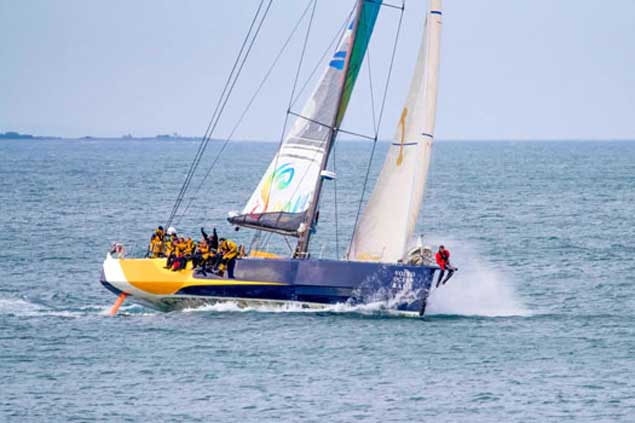 The old war horse. The Volvo 70 Monster Project coming to the finish to take line honours in the 2014 Round Ireland Race. She’s still going strong, and is one of the entries in the RORC Transatlantic Race. Photo WSC
The old war horse. The Volvo 70 Monster Project coming to the finish to take line honours in the 2014 Round Ireland Race. She’s still going strong, and is one of the entries in the RORC Transatlantic Race. Photo WSC
Yet the way things are provides something for everyone in the audience. While we pay lip service to approving the moves towards synchronising the IRC and ORC measurement systems, there’s a little bit of us that thinks it’s actually a pretty good idea having the two, as it allows for even more prizes, and they keep up the interest across a broader spectrum of the fleet.
Equally, an almost mind-numbing variety of events and organisations, a whole world away from the rigid one design format proposed for the Olympics offshore racing tryout, is what the global scene in the offshore game is all about. Think, for instance, of the 240 people from both sides of St George’s Channel who gathered at the Irish Sea Offshore Racing Association’s annual black tie dinner and prize-giving earlier this month in the National Yacht Club. All power to the great Peter Ryan for organising it, these were genuine sportsmen and women who are dedicated to their interest afloat, yet somehow trying to link them directly to the sterile world of the Olympics just doesn’t make sense.
At the other extreme, our own deservedly admired 2016 Olympic Silver Medallist Annalise Murphy instantly made herself much more interesting, much more of a three-dimensional character, when she courageously took on the crewing job aboard Turn the Tide on Plastic in the Volvo Ocean Race. There’s no doubt that having the fitness of an Olympic athlete is a real asset in a Volvo 65, but the concept of the Volvo Ocean Race is a million miles from Olympic theory.
In a different direction, sailing also includes the craziness of the America’s Cup, but in the offshore and ocean sphere, it’s generally agreed that the supreme event is the Vendee Globe. Nothing could be simpler in concept than one sailor on his or her own racing non-stop round the world out of a French port which finds it has stumbled on a world-beating event. Yet nothing is more complex than the actual machinations of the Vendee Globe, but the Olympic ideal it ain’t.
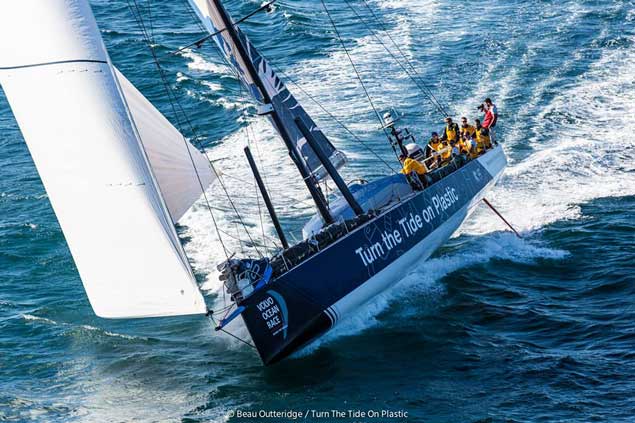 A very different machine from a Laser Radial – Silver Medallist Annalise Murphy is one of the round the world crew on turn the Tide on Plastic
A very different machine from a Laser Radial – Silver Medallist Annalise Murphy is one of the round the world crew on turn the Tide on Plastic
But despite these enormous difference, the fact of offshore racing becoming linked to the Olympics might make life a little easier for people like Tom Dolan who have literally re-invented themselves in the strange world of solo offshore racing, but find it extremely difficult to explain to non-sailors, especially those who might have a sponsorship budget, just what’s going on. However, mention the Olympics, and it’s a bit of a light-bulb moment.
That said, the proposed Olympic offshore course will be light years away from what Tom Dolan and his comrade-rivals put themselves through during the first 15 and more days of November. We carried an extract of winner Erwan Le Daroulec’s take on it earlier this week, but it’s worth repeating (and don’t sign off, the real meat of this week’s blog is at the end). Le Draoulac wrote:
“I brought a book with me, but I never thought to read it. I helmed, I ate, I slept, I answered the calls of nature, a real animal life. It was a nightmare.
The boat was soaked the whole time. I never dumped any sails, I just went up forward to reinforce my bowsprit. To get to sleep when I was under autopilot, I put on my headphones with some audio books and I listened again to the whole of Harry Potter. It was the only way of preventing stress whilst the boat was powering along at 18 knots, sometimes under autopilot, but I never eased off the pace.
It was only in the last two days where I dropped the large spinnaker in the squalls. I said to myself that it would be too silly to break everything so close to the goal. Prior to that though I really attacked hard. I knew I was risking a dismasting, but my line of thinking was that I was only twenty years old and that I’d have the opportunity to do another Mini-Transat. I didn’t make the most of it, I didn’t enjoy it. I’d like to the cross the Atlantic again, but gently so as to make the most of it.”
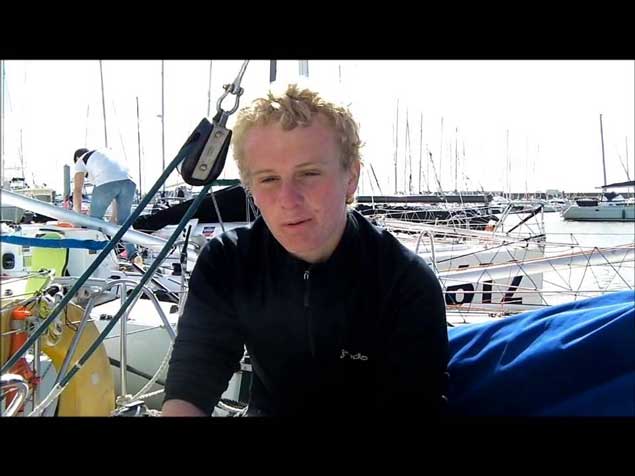 Erwan le Draoulec – he won, and won well, but says he didn’t enjoy it at all
Erwan le Draoulec – he won, and won well, but says he didn’t enjoy it at all
We really must try a dose of the old Harry Potters the next time insomnia comes along…..but seriously, what sort of a sailing world have we created, that a 20-year-old old is trained to such a level of performance that he can turn in an incredibly brave and skilled world-beating performance, yet actually hates every minute of it?
That said, Tom Dolan reckons he only feels truly alive when he’s “in the zone”, racing his little boat flat out. However, since he finished he has quietly revealed that, two days out from the finish, he survived an experience which was beyond fulfilling.
He was running in the dark in about 30 knots of wind and going a dream under the small spinnaker, nicely on track for fourth with a good chance of a bite at third, when out of the still-total blackness a 45 knot squall struck. IRL 910 went faster and faster, then a steep one lifted her from astern, and the tip of her stemhead went under the bow-wave. Within seconds, she’d done a complete pitchpole.
Tom found himself in the water in the dark, and his boat inverted for what seemed forever beside him. But she shook herself upright, he hauled himself aboard, and to his amazement everything, rig and all, still seemed intact. It was the first time he’d ever heard of a Min-Transat boat pitch-poling and not being dismasted, and miraculously it had happened to an under-funded Irishman who was campaigning on little more than wing and a prayer. He still had his wing. He will have sent have up a little prayer of thanks.
Then it was right back full on into the race, and we’ve all seen the vid of him finishing. But it’s worth repeating. You’re looking at a real hero.
He was within 48 minutes of being third and on the podium, but it was miraculous he was there at all. As for the final overall placings based on the total accumulated times for the two legs, the word is that won’t be officially announced until the Paris Boat Show on December 8th, when they’ll also stage the prize-giving.
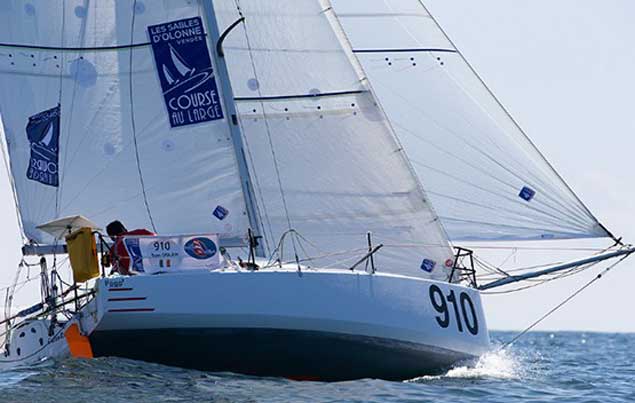 Tom Dolan with his new boat in 2016, when he won his first race. It has been revealed that he came fifth in the second leg of the Mini Transat despite being pitch-poled two days before the finish
Tom Dolan with his new boat in 2016, when he won his first race. It has been revealed that he came fifth in the second leg of the Mini Transat despite being pitch-poled two days before the finish
At the Paris Boat Show they’ll also officially announce the Golden Globe 18, golden oldies of a past era racing round the world in celebration of the Golden Jubilee the original Golden Globe, the non-stop round the world solo race of 1968 which was won by Robin Knox-Johnston in Suhaili. To be eligible, you have to be racing a “closed profile” (ie non fin-and-keg) boat of around 36ft, and Ireland’s Gregor McGuckin is entered with a Biscay 36 which he is currently preparing.
But as the organisers couldn’t get any British port associated with the original race to take it on fifty years later, Les Sables d’Olonne in France, home of the Vendee Globe, stepped up to the plate, and they will be the host port. It’s a perfect illustration of the huge spread of French interest in offshore racing. In fact, you might be making a sensible wager if you bet on France to support the new offshore event in the Olympics, but only if they can present the medals at the subsequent Paris Boat Show…
Meanwhile, as to Ireland being ready and willing for involvement in an Olympic offshore racing class, we certainly have plenty of keen young ocean racers, both men and women, who will be mustard keen if the resources can be found to get their campaigns under way. But as it is, the world of offshore racing is already rich in its diversity without being forced into any Olympic straitjacket. And that’s the way it is in Ireland too. We seem to like it that way too, but if the Olympics come calling, they’ll be welcome to join the party.
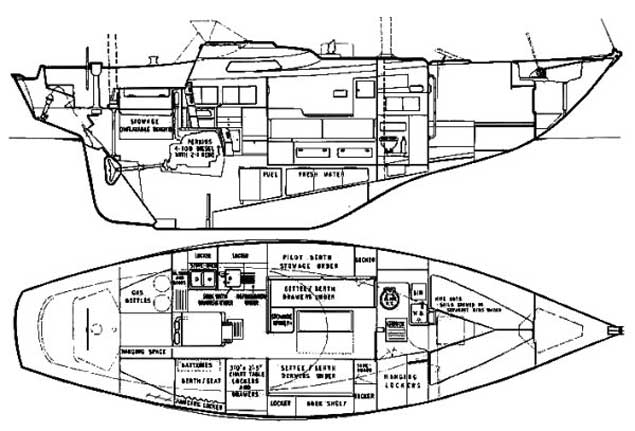 Tough and compact – the hull profile of a vintage Biscay 36. Ireland’s Gregor McGuckin will be racing one in next year’s Golden Jubilee of the Golden Globe Race. But despite the original having started and finished in England, the 2018 version will start and finish in France
Tough and compact – the hull profile of a vintage Biscay 36. Ireland’s Gregor McGuckin will be racing one in next year’s Golden Jubilee of the Golden Globe Race. But despite the original having started and finished in England, the 2018 version will start and finish in France
Michael Boyd's First 44.7 is RORC Yacht of the Year
Over 500 boats took part in the 2017 RORC Season's Points Championship, with teams flying the flags of 30 different nations from Canada to Russia and Chile to New Zealand. Well over 4,000 sailors took part, and whilst the majority of the races were in the English Channel, the Championship included the Atlantic Ocean, the Caribbean Sea, the Celtic Sea, the Mediterranean Sea and the North Sea. The 13-race series, which this year included the Fastnet Race, is truly international and it is the largest offshore series by participation, anywhere in the world. For the serious offshore sailor, winning the championship is a real challenge.
Lisa - Overall winner - 2017 RORC Season's Points Championship
The overall winner of the 2017 RORC Season's Points Championship is Nick & Suzi Jones' British First 44.7 Lisa, skippered by RORC Commodore Michael Boyd. The corinthian team retained the title from 2016; the only yacht to achieve the double since Piet Vroon's Dutch Ker 46 Tonnerre de Breskens (2011-12). Gilles Fournier & Corinne Migraine's J/133 Pintia was second overall and Thomas Kneen's JPK 1080 Sunrise was third.
Lisa - 2017 RORC Yacht of the Year
Lisa has also been awarded the RORC Yacht of the Year, winning the Somerset Memorial Trophy for an outstanding racing achievement by a yacht owned or sailed by a RORC member, as voted for by the RORC Committee.
"This has been a tough season, winning the championship in a Fastnet year makes it even more of a challenge," commented Lisa's Nick Jones. "Our goal was to defend our win in 2016 and to be awarded RORC Yacht of the Year is beyond our dreams. Michael (Boyd) has been an inspiration, especially to the young crew, whose energy and tenacity has been fundamental to our success. The youth sailors at the RORC are the future of offshore sailing and we will be using our contacts and experience to help them. Lisa will not be racing next year so it is great to finish the adventure on such a high. Next season, Suzi and I will spend our time with our children; Charlie, Freddie and Toby, teaching them the joys of sailing in Chichester Harbour."
|
|
The impressive fleet for the RORC Season's Points Championship is separated into six classes racing under IRC, a Class40 Division and a Multihull Class. Two outstanding results from this year's Championship were in IRC Two Handed and IRC Four.
Bellino - IRC Two Handed & Mixed Two Handed
Rob Craigie's racing Sun Fast 3600 Bellino with Deb Fish, was the winner of the IRC Two Handed Class. Racing in a fleet of 78 teams, Bellino fended off a strong challenge from Ian Hoddle's Game On, and Ed Fishwick's Redshift Reloaded.
"Game On and Redshift were always at our heels; we couldn't relax at any moment, in any race," commented Craigie. "Whilst all three boats are Sun Fast 3600s, there are different keels and rigs, so we all have strengths and weaknesses in different conditions. Deb Fish has been my sailing partner all season. She is very good at the analysis, whilst I am the more experienced seaman, and in terms of boat speed, we are an equal match, so it is a great synergy."
|
|
|
|
Foggy Dew - IRC Four
Noel Racine's French JPK 10.10 Foggy Dew has been in scintillating form, securing the class win in IRC Four in a fleet of 116 boats, with two races to spare. Foggy Dew's winning streak in the Championship dates back to 2013.
"Every year we have to start as new; we have changes to the crew and the competitors are different," commented Racine. "Winning is not about doing one thing well, it is about attention to detail. Preparing the boat, the sails and the equipment, and reacting to changes on the race course. In IRC Four, we race against all different types of boat, but I believe that Foggy Dew is a good all-round performer."
The Annual Dinner and Prize Giving for the 2017 RORC Season's Points Championship is a spectacular event where prize winners, competitors, crews, RORC members and guests will celebrate the achievements of 2017.
The full list of 2017 winners can be found below or HERE
Results can be found here
IRC Congress Looks to the Future
Another successful annual IRC Congress meeting was held in early October in the popular sailing venue and race destination of St Malo on the northern French coast. Forty delegates from as far afield as Japan and the USA came together to talk about the International Rating Certificate (IRC) racing around the world, technical development and ideas on encouraging participation in yacht racing generally.
In 2018, there is the exciting prospect of the IRC European Championship combined with the RORC’s Commodores’ Cup in Cowes in June, closely followed by the joint IRC and ORC Hague Offshore World Championship in the Netherlands in July. These events set the high standard for IRC racing in 2018, along with the major offshore classic races that continue to be scored using IRC.
However, the IRC Congress never loses sight of the core of the IRC fleet who are taking part in club racing around the world every week and much talk at Congress was how to further encourage this. Everyone agreed that exciting events drive participation. This is demonstrated by the record four minutes for the Rolex Fastnet Race entry to be fully subscribed and the large number of boats that entered the Offshore Worlds straight after registration opened. Clubs were encouraged to put on events that provide an escape from the stresses of modern life, with a variety of courses, and some longer races with interesting destinations.
The IRC Technical Committee has been working on technical developments including the rating of boats equipped with foils, and a longer term review on rating ‘code zero’ sails. IRC has always been fast to embrace new developments in yacht design, while as far as possible retaining the characteristic simplicity of the IRC Rule and avoiding too much complexity for the majority of owners.



























